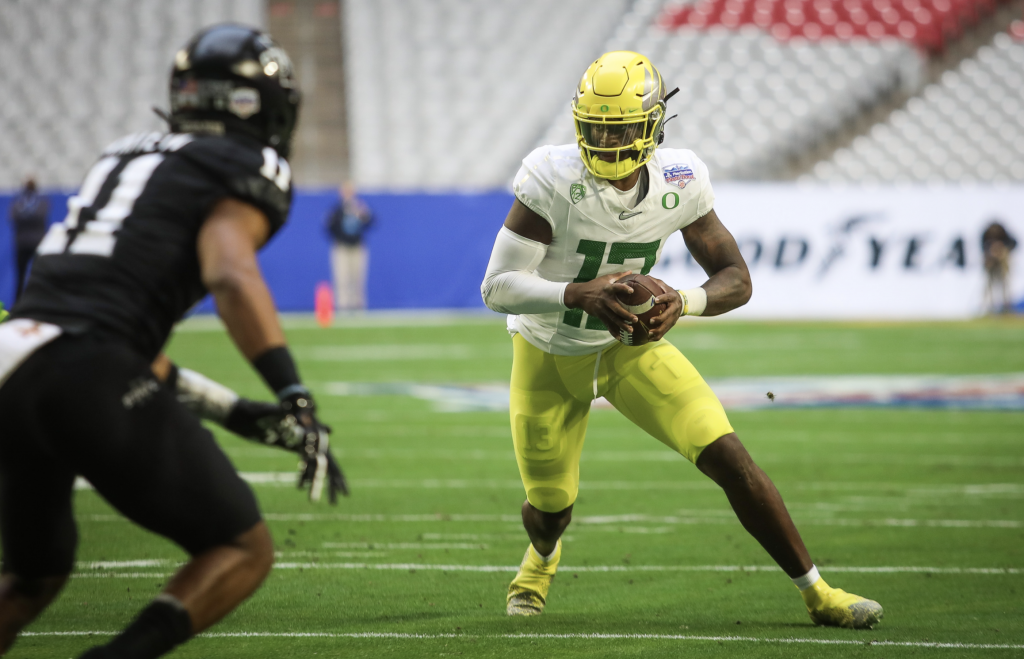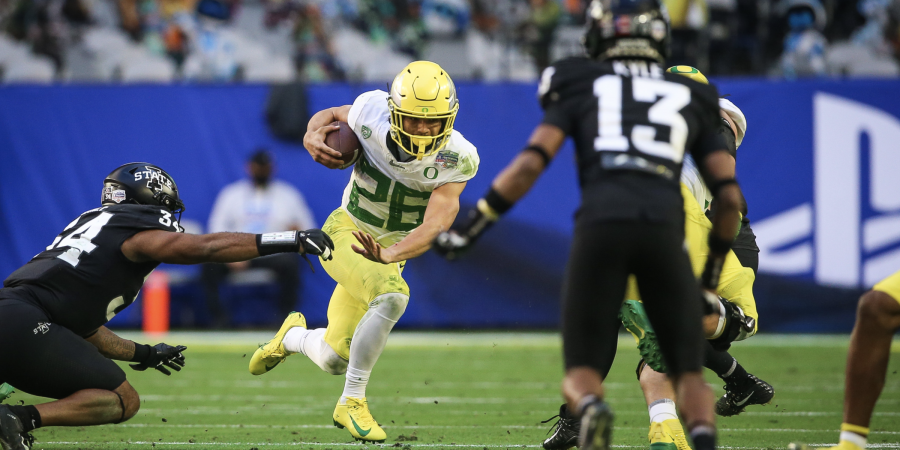For better or worse, a truly up and down season of Oregon football has come to an end.
Though the Ducks wave goodbye to a COVID-marred 2020 season that was highlighted by a second straight Pac-12 Championship, they will enter 2021 with a bittersweet taste in their mouths following a resounding 34-17 defeat in the Fiesta Bowl to the 10th-ranked Iowa State Cyclones.
Saturday’s loss to Iowa State was in many ways a snapshot of Oregon’s season on the whole. Defensive struggles, shaky quarterback play, a disconcerting rash of turnovers, and failure to turn the opposition over each served to underscore the Ducks’ performance in this game.
Yes, the Ducks held the distinction of being the most inexperienced team in FBS this season, and yes, it was a season unlike any season before it thanks to a once-in-a-century global pandemic, but anyone associated with the Oregon program would tell you that what was seen inside the confines of State Farm Stadium in Glendale, Ariz. falls woefully short of the expectations that followed this team coming off a magnificent 2019 campaign.
With the offseason lying ahead and no shortage of questions on the horizon, WFOD offers up it’s biggest takeaways from Oregon’s Fiesta Bowl loss to Iowa State.
1. Turnovers on offense, special teams undo the Ducks
If you’re unaware of how problematic turnovers have been for Oregon this season, welcome to Whole Flocks of Ducks. It’s nice to see you and we hope you enjoy the site.
If you are aware, then what you saw from Oregon on Saturday was simply an extension of the sloppy play that has become an unsightly hallmark for this team this season. Entering the day, the Ducks were tied for ninth in the Pac-12 in giveaways with 12. After today, Oregon will occupy the Pac -12 cellar in this category all by themselves, as the five turnovers they committed (and the zero turnovers they forced) against Iowa State effectively torpedoed any chance the Ducks had of clawing their way back into this game.
A Travis Dye fumble and a beautifully executed pooch kick in the first half helped the Cyclones keep the Ducks at arm’s length entering halftime with a 28-17 lead. From there, a botched Oregon punt return, an Anthony Brown fumble, and a Tyler Shough pick would be all Iowa State needed to put the finishing touches on a historic season for head coach Matt Campbell and the Cyclones, as the Ducks were shut out in the second half for the second time in their last three games.
Kick of the year pic.twitter.com/dfbnEMBJhZ
— PFF College (@PFF_College) January 2, 2021
2. Third down was a nightmare
It may sound simple, but it’s difficult to summarize Oregon’s performance on third down any other way. In a season where the Ducks have struggled to be efficient on both sides of the ball, Saturday’s game vs. Iowa State was especially galling.
On offense, the Ducks failed to convert a single third down attempt the entire game, going 0-for-6. To put it into perspective, the last time the Ducks failed to convert a single third down in a game was 2001.
Adding insult to Oregon’s inability to convert on third down was Iowa State’s remarkable success against the Duck defense in third down scenarios. The Cyclones finished the game 11-for-19 on third down conversions, as the Iowa State offense seemingly had an answer at the ready for whatever the Oregon defense threw at it.
As backbreaking as the turnovers (or lack thereof) were, Oregon’s staggering shortcomings in critical down and distance situations was arguably just as much of a contributing factor to the loss.
3. Oregon got out-physicaled by Iowa State and was drubbed in time of possession
It’s not often that you see a team nearly double up the number of plays run on offense compared to their opponent, but that’s essentially what took place in Glendale Saturday afternoon.
Employing a balanced and stunningly controlled offensive attack, Iowa State racked up 85 plays on offense compared to Oregon’s 45, possessing the ball for 42 minutes and 48 seconds of a 60-minute game. Paced by 34 carries for 136 yards and two touchdowns from star running back Breece Hall, the Cyclones quite simply out-physicaled the Ducks at the point of attack, methodically moving the ball up and down the field by chunking four to five yards per play and taking the air out of the football.
Iowa State’s first half performance on offense was particularly instrumental, as the Cyclones gained 259 out of 260 possible yards in the opening two quarters, with four out of five possessions ending in touchdowns. The lone yard that wasn’t gained by Iowa State in the first half came on an inspired goal line stand that saw the Ducks turn away the Cyclones on 4th and goal from the Oregon 1-yard line.
In the end, it was a humbling way for Oregon head coach Mario Cristobal and the Ducks to be served defeat, as the Ducks under Cristobal have prided themselves on being the tougher and more physical team when games have turned into slugfests.

4. Shough and Brown takes turns leading the Oregon offense
For those seeking clarity at the quarterback position for Oregon heading into 2021, Saturday’s game likely provided more questions than answers. In the build up to the Fiesta Bowl, the prevailing question was who would start at quarterback for the Ducks between incumbent starter Tyler Shough and Boston College grad transfer Anthony Brown.
Named the starter to begin the season, Shough’s starting status of late had become rather murky, as subpar performances in his three previous outings raised serious questions as to whether he would earn the start Saturday vs. Iowa State. Shough would end up starting his seventh game for the Ducks, but played just two offensive possessions (completing all three of his pass attempts) before giving way to Brown for a large portion of the remainder of the game.
Brown was mostly effective at the controls of the Oregon offense, displaying much of the same poise and confidence he exhibited in limited debut action against USC in the Pac-12 Championship Game. Brown’s six-yard touchdown run in the first quarter was followed up emphatically by a 98-yard touchdown drive that was capped off by a 16-yard scoring scamper from Brown again to tie the game at 14 a piece. Though the offense would bog down in the second half, Brown finished the day completing 12-of-19 passes for 147 yards, while adding 36 yards and two touchdowns on the ground.
Those searching for mistake-free football likely walked away disappointed with the performance of both players, as Shough (an interception) and Brown (a fumble) proved unable to shake the turnover bug. How Cristobal manages his quarterback quandary heading into spring will likely be the biggest question he faces as he and the program shift their focus to 2021.
5. Questions abound heading into next season
A full-blown quarterback controversy isn’t the only thing facing the Oregon football program as they head into an offseason with a bittersweet taste in their mouths.
Firstly/most immediately, the Ducks may need to address the prospect of potentially replacing both their offensive and defensive coordinators next fall. First-year offensive play-caller Joe Moorhead has been tangentially rumored to be a candidate for a handful of FBS offensive coordinator openings across the country, while second-year defensive coordinator Andy Avalos is considered a lead candidate for the head coaching vacancy at his alma mater Boise State. This, after Dallas Cowboys offensive coordinator and former Boise State quarterback Kellen Moore reportedly turned down the opportunity to instead sign an extension in Dallas.
Offensive coordinator Kellen Moore has signed a multi-year contract extension to remain with #DallasCowboys
Read more in Breaking News | @lgus ⬇️
— Dallas Cowboys (@dallascowboys) January 3, 2021
There’s also the question of which players remain with the program and which players move on as spring approaches. With the 2020 season effectively serving as a free season for all fall sport athletes, a number of Oregon seniors (see Jaylon Redd, Johnny Johnson, and Deommodore Lenoir) will be forced to decide whether they want to return for a second senior season, or enter the 2021 NFL Draft. Additionally, with college rosters expected to swell next year due to the NCAA’s eligibility ruling for this season, the transfer market is expected to be an especially attractive option for individuals who feel like playing time may come at a premium in 2021.
Cristobal and his staff must also determine how they want to round out the few remaining spots in their 2021 recruiting class while simultaneously navigating the uncertain waters as it relates to their pursuit of recruits in the 2022, 2023, and 2024 recruiting classes. Due to the COVID-19 pandemic, high school and junior college recruits have been unable to take the unofficial and official visits that are typically afforded to them, robbing both players and coaches of the opportunity to evaluate schools and prospects, respectively.
Top Photo: Oregon RB Travis Dye (Oregon Football/Twitter)

